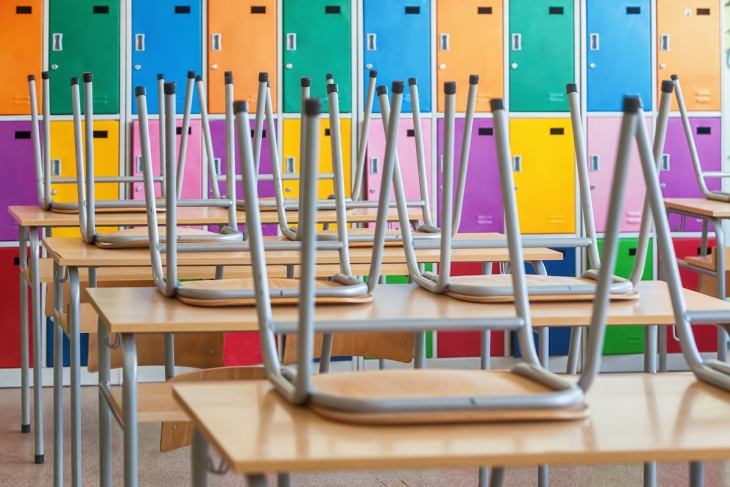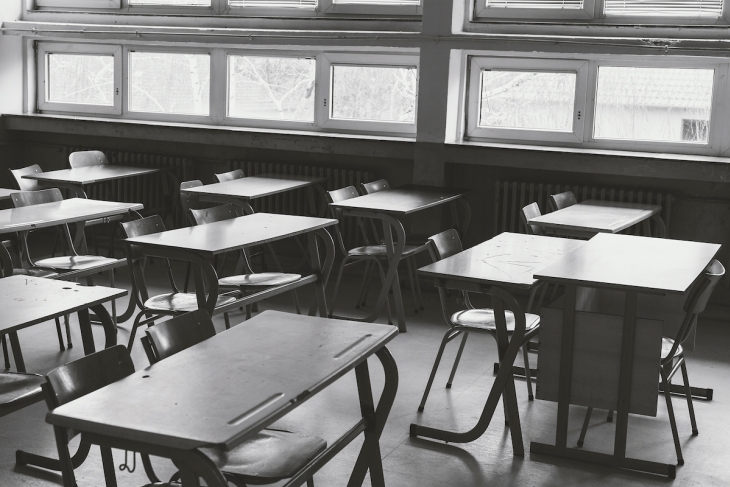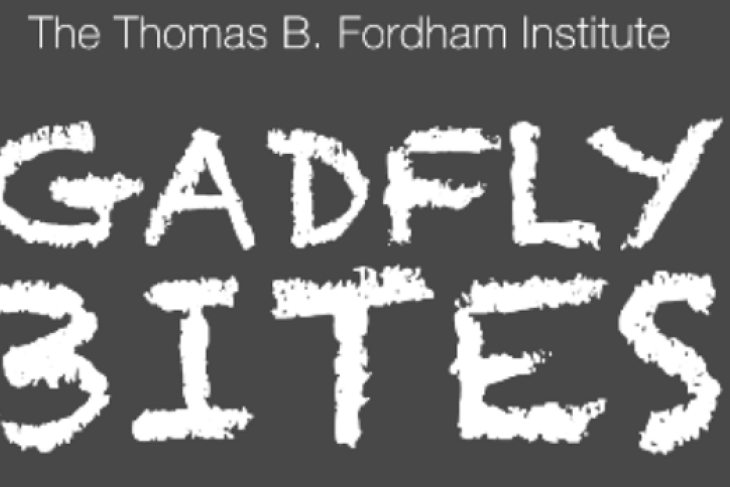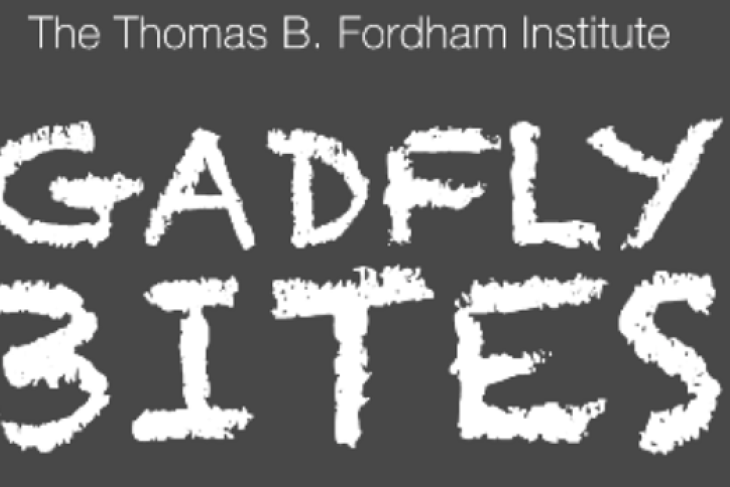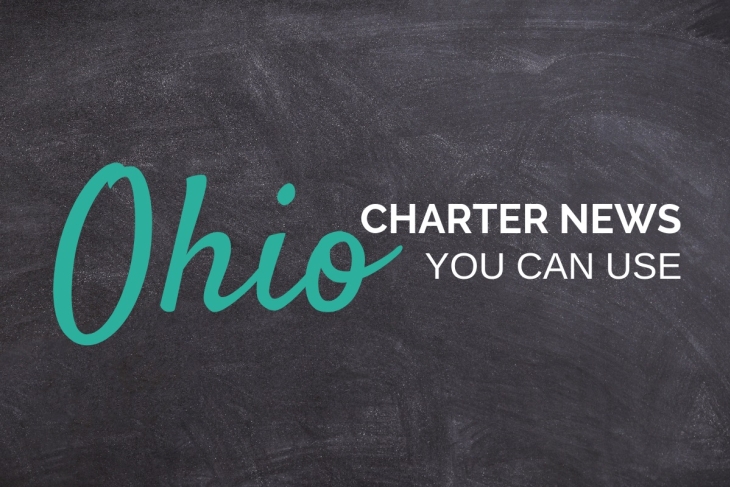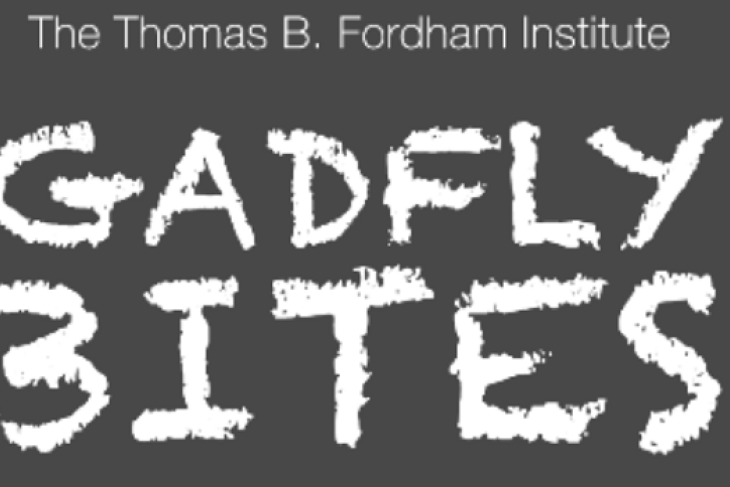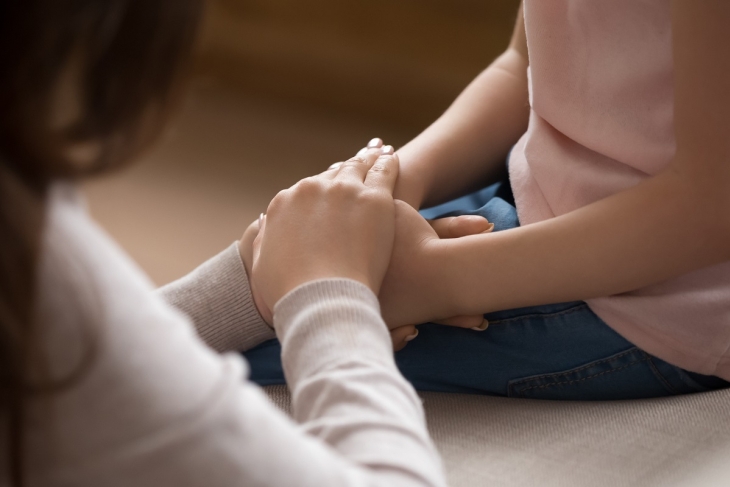More than 100,000 public schools across the country have closed in response to the COVID-19 pandemic. Many are expected to remain closed for weeks, and in some cases, for the remainder of the 2019–20 school year. A project from the Center on Reinventing Public Education is tracking how districts shift instruction, student support, and organizational operations. See it here.
Three much-admired school networks in Indianapolis didn’t skip a beat in going virtual.
At Purdue Polytechnic High School, which enrolls 442 students at two campuses in the city, remote learning kicked off Monday, March 16, after schools had closed throughout the city the previous Friday afternoon. By Tuesday, March 17, 95 percent of Purdue’s North Campus students were attending virtually—slightly above the school’s average daily attendance.
Last year, Purdue students, 65 percent of whom are children of color and more than 50 percent of whom are in low-income households, outperformed students statewide on Indiana’s ISTEP high school assessment and trounced their district peers, with nearly twice the number of students passing both the math and English Language Arts components.
When the crisis came, there was little need for reinvention. In a charter school that stresses project and experiential learning, students were accustomed to working on their individual laptops. Instead of gathering in person each morning in their “personal learning communities,” they simply signed in to Google Hangouts for a video meeting with their classmates. To sustain their community, students gave one another virtual tours of their home settings. For much of the day, students continued to work in small groups, connected by video, as they tackled their fifth major project of the year. Sophomores are working with staff at Eli Lilly on a specific problem of their choosing that engages the larger question, “How might we expand the healthy human life cycle worldwide?” Upon the project’s completion, they will be assessed on three key academic and professional skills.
Students continue to master academic content, aligned with state standards, on Edmentum, an online learning platform, where they watch brief instructional videos and complete online assessments to demonstrate mastery. Small-group academic interventions, or dojos, are now held on Web Whiteboard, and every student receives one-on-one coaching at least once a week. Scott Bess, head of school, explained that individual and group counseling continues and that schools are working with itinerant providers to sustain student services. Even the network’s nurse is online and offering virtual yoga classes to students who may be experiencing anxiety. “We believe strongly that there are ways of providing PT and OT in creative ways,” he told me. “We’ve been documenting the time and services we’re providing.” Bess is undeterred by legal uncertainty over special education compliance and virtual schooling. “We are absolutely not going to say that because we might get sued by someone, we’re not going to provide education.” He explained that the risk is minimal because his staff stays very close to parents.
Perhaps surprisingly, connectivity proved barely an issue. A few students needed help in obtaining discounted internet connections; the school gave a handful of others mobile hotspots.
Distance learning also launched Monday at Paramount Schools of Excellence, which operates three charter schools educating nearly 1,000 children in kindergarten through eighth grade—83 percent from low-income households. Paramount’s flagship school, Paramount Community Heights, was the highest-scoring school in the state last year. Tommy Reddicks, Paramount’s CEO, told me the network began intensive preparations for the pandemic in February. “No teacher didn’t understand this might be coming. We took the perspective that we want to be the best in the country at this.”
He credits the smooth launch to the network’s devotion to systems. “We have top-down buy-in for systems-based and standards-based education, full of rigor,” he said. “To protect our investment, we knew we had to be ready to transition with high fidelity.” Because digital testing in the state began a few years ago, the school already had one device for every student. An elaborate call center was established in each school to triage concerns from parents, whether regarding technical support, translation services, academic needs or nonacademic needs such as day care—“anything that could be breaking down in the home,” as Reddicks put it.
Schools are following an 8:00 a.m–3:00 p.m. schedule, barely shorter than before. The day begins with two hours of synchronous instruction, with parents and students engaged by chat. Pearson online products continue to be tapped, as before, for both math and reading; teachers can track students’ progress throughout the day. Reddicks stresses that K–2 is harder; for now, the school is relying on distributing physical packets and picking them up later in the week.
Reddicks expressed great admiration for parents’ commitment. “It’s horrifying to see how many parents will be put out of a job” because of the pandemic’s disruption. “The levels of stress must be out of control,” he said. But on Facebook, parents universally praised the network’s characteristic attention to detail.
Eight hours of instruction a day will not be possible, Reddicks recognized. “But we can build up parent rigor over time. We are parent coaches for now. We can tackle this thing here, and that thing there, with them. We can help to find a way to make it work.”
Reddicks condemned those who invoked legal obstacles to continuing schools. “It’s ethically out of control. It’s almost like you’re reverse-engineering a reason not to serve kids. These are serious cop-outs. Doing nothing is much worse than doing it virtually. We can’t be the ones responsible for our students not moving forward in life.”
Indianapolis Classical Schools operates two high schools, Herron and Riverside, offering a classical liberal arts education to a diverse student population of 1,298. Organized as “innovation schools,” a form of in-district charter, both schools launched e-learning without delay on Monday. In 2018 U.S. News and World Report ranked Herron, where the student body is approximately half students of color and half white, as the number two public high school in Indiana.
Students sign into Haiku, a digital learning platform, and attend online office hours with their teachers through video calls. Parents and students receive daily automated text messages as assignments are completed. I spoke with one twelfth-grade student, Ashantea Gilliard, who will be attending the University of Evansville next year, about her experience with her first days of remote learning. She allowed that it has been emotionally difficult. “I’ve struggled to have motivation,” she told me, “but I’m motivated to graduate.” Because of a class trip to Taipei last November, she is behind in her work in Latin and English. She misses her classmates and their vivid personalities. “It’s isolating,” she said. Some students have set up group chats and are working on assignments together. In a blow to the school’s community, an athletic coach was diagnosed with COVID-19 last week, but staff and students continue to press forward.
As the pandemic gains force, it may be that the already vast discrepancy in quality among schools in the United States will be obscenely amplified. Schools, networks and districts like Purdue, Paramount and Indianapolis Classical will move insistently to preserve their students’ education: schools that are determinedly focused on results and fueled by a can-do spirit, benefit from a distinctive vision and accompanying rituals and traditions, deploy richly developed and vigilantly maintained systems and structures, and enjoy the passionate subscription of staff and parents. At least for now, schools lacking these assets will hesitate and, ensnared by legal and compliance concerns, either remain closed altogether or point students to an incoherent array of online resources. What then will happen?
Editor’s note: This article was first published by The 74 Million.
- While every public school and district in the state is required to have a school safety plan on file, these are not generally public knowledge, much to the chagrin of some reporters. And, it seems, none of them really include details on what to do in case of a sudden multi-week shutdown due to a pandemic. I feel like that should be the main point here, but do remember that a Columbus City Schools staffer told us earlier in the week that her district at least had already been planning for such a thing. (Columbus Dispatch, 3/25/20) The real point is that most schools—and the state education hierarchy—are making this up as they go along. I predict that we will see some parallels in this response to other education issues we follow here. To cite just a few of examples from current reportage, Mansfield City Schools is said to be preparing a second packet of school work to be delivered to its home-sheltering students to work on. (Richland Source, 3/22/20) Meanwhile, Lorain City Schools still seem to be working toward their first one. (The Morning Journal, 3/23/20) And Warren City Schools is already halfway to its goal of getting laptops to all their middle and high school students. (WKBN-TV, Youngstown, 3/24/20)
- All this winging it will have knock on effects, of course. One which we have mentioned before is the putative cancellation of all state testing for the year. Innovation Ohio’s Steve Dyer sounds pretty giddy about that prospect here (as you might expect); but there is also the matter of unfinished College Credit Plus courses to consider. (Cincinnati Enquirer, 3/23/20)
- The General Assembly is supposed to get to grips today with their response to all this mess; including the education stuff. Not just testing but also graduation, report cards, third grade reading, and vouchers. Oh, and the matter of what about teaching during the remainder of the school year. Patrick O’Donnell gives a nice overview of the issues here. (Cleveland Plain Dealer, 3/24/20)
- In News from a Different Universe: Families attending and living around Colerain Elementary School in Columbus are celebrating victory after a three year effort to get an accessible, multi-use Wellness Path built. (ThisWeek News, 3/20/20) An Athens County multi-age, all outdoor homeschooling co-op called a “nature school” was apparently going gangbusters in its first year before, well, you know. (Columbus Dispatch, 3/24/20) Mike Petrilli and Pedro Enamorado tell us that getting into a selective college via SAT scores has become harder over a generation. Explains a lot of what I’ve experienced over the last year of college searching with my kids. (EdNext, 3/24/20)
- In Editorializing from a Different Universe. The Dispatch editorial board opined on the topic of for-profit charter school operators. Or, as they call it: “profiteering”. (Columbus Dispatch, 3/24/20)
The Knowledge is Power Program, or KIPP, is the nation’s largest charter school network. It currently operates 240 schools that serve more than 100,000 students, the vast majority of whom are low-income students of color. The network is widely known for its sizable impact on student achievement, as demonstrated by standardized test scores, but there are less data on longer-term outcomes like college enrollment, persistence, and completion.
To remedy this lack of post-secondary data, a recent report examines two key questions: the impact of KIPP middle schools on students enrolling in four-year colleges, and the impact on students persisting in those colleges for two consecutive years after high school graduation. The report follows a sample of 1,177 students who applied to a fifth or sixth grade admissions lottery for the 2008–09 or 2009–10 school year in the hope of enrolling at one of thirteen oversubscribed KIPP middle schools located throughout the country. Data from a total of nineteen admissions lotteries were used, with each lottery representing some combination of school, cohort, and entry grade levels.
The report uses a variety of sources: college enrollment data from the National Student Clearinghouse, administrative data from the Integrated Postsecondary Education Data System, and student rosters provided by the KIPP Foundation. Baseline data on the sample came from a prior KIPP middle schools study that included lottery application records and demographic and socioeconomic information.
The authors used a random assignment design to ensure that treatment and control groups were similar on both observable and unobservable characteristics. They conducted two analyses. First, they used a primary impact estimate to compare students who received an admission offer via the lottery to students who didn’t. They note that this is a more conservative approach, since it includes students in the treatment group even if they declined their enrollment invitation. In an exploratory analysis, however, the authors focused on students who actually attended a KIPP school in order to more directly measure KIPP’s potential effects.
Now for the findings. First, KIPP middle schools had a positive and statistically significant impact on enrollment in four-year colleges. On average, students who received an admissions offer were 6.9 percentage points more likely to enroll in a four-year college than students who applied to a lottery but were not offered admission. When focusing on students who actually attended KIPP, the impact estimate nearly doubles to 12.9 percentage points. They note that an effect of this size represents a “meaningful change” in college enrollment rates given the national gap between white and black or Hispanic students. To wit, “The impact of attending a KIPP school (10 to 13 percentage points) would be almost large enough to erase the nationwide racial disparity in college enrollment rates,” write the authors.
The effects on college persistence are also encouraging, though not quite as clear as the enrollment findings. The primary impact estimates indicate that students who received KIPP admissions offers were 4.8 percentage points more likely to enroll in a four-year college after high school graduation and remain enrolled for two years, although that difference was not statistically significant. Digging deeper, the exploratory analysis found that roughly 33 percent of students who attended KIPP enrolled in a four-year college and persisted for two years, compared to around 24 percent of student who did not attend KIPP. However, this difference of 9 percentage points was not statistically significant.
Overall, the magnitude of KIPP’s impact on four-year college enrollment was larger than for college persistence. The authors explain that this difference could be due to multiple factors. For instance, the initial enrollment effect could be fading over time if treatment group students drop out at higher rates, enroll in college later, or transfer from two-year to four-year colleges at higher rates.
The students in this study have only had enough time to complete two years of college, so it’s still too early to know whether KIPP will lead to improvements in college graduation rates. But the authors note that the estimated impacts on persistence are worth considering in relation to potential future college graduation rates. “If a future study revealed that KIPP middle schools ultimately do have an effect of approximately 9 percentage points on college completion, that effect would be equal to more than a third of the degree-completion gap for black and Hispanic students,” they write.
If this does indeed turn out to be the case, KIPP deserves considerable praise for helping more students get to and through college. It’s also worth noting that KIPP has changed its model considerably since the late 2000s when the students in this sample were in middle school. These changes were made in part because the network reviewed its own data and found that many graduates were getting to college but weren’t making it through college. As a result, it’s possible that KIPP’s long-term impacts will get even bigger over time once researchers begin to study samples of students that attended KIPP after the network’s changes.
Source: Thomas Coen, Ira Nichols-Barrer, and Philip Gleason, “Long-Term Impacts of KIPP Middle Schools on College Enrollment and Early College Persistence,” Mathematica (September 2019).
- We’ll start today with a bit of grim humor. (Seriously, what else did you expect from me?) How can we be sure that the current situation is an emergency? Because the Chronicle published a good story about a charter school – virtual spirit week being held for the students at Summit Academy in Lorain – which actually notes that Summit is a charter school. Unprecedented times indeed. (Elyria Chronicle, 3/23/20)
- But despite that tiny bit of levity, the story of the day in our clips is of seeking—lots of people seeking things these days. First, from late last week, we have a state rep who will be seeking safe harbor for all schools from the results of any state testing that might be conducted this year. (Gongwer Ohio, 3/20/20) Of course, Governor DeWine has since told us he is seeking a waiver for Ohio from federal testing requirements. (Gongwer Ohio, 3/22/20) As such, it seems that the final version of any safe harbor bill will seek to focus only on diagnostic-type testing that may be conducted across the state. (Columbus Dispatch, 3/22/20) It came a little sooner than even my cynical self expected—and from a source I had not expected—but the call seeking diplomas for almost all members of the
coronavirus classClass of 2020 no matter their graduation status now has come. (WKYC-TV, Cleveland, 3/22/20) Never ones to miss an opportunity, Lorain’s elected school board is using the existence of “unprecedented times” to seek a no-strings-attached immediate end to Academic Distress Commissions in the state. They even have two completely different reasons! One is that they are sure that ADCs will be ended either via legislation or via court ruling and doing it now will just speed up the inevitable and allow them to get started fixing things up at their earliest opportunity; the other is that the inevitable cancellation of testing and/or safe harbor for results this year will rob the district of a year of growth (!) toward ending ADC control naturally. Clever (The Morning Journal, 3/22/20) Meanwhile, parents are just seeking education for their kids. Several O.G. homeschool parents and some education profs have advice. (Cleveland Plain Dealer, 3/23/20) Here are some virtual education resources available in the Toledo area. I read this seeking out what the school district was doing in this regard. Didn’t find it. (Toledo Blade, 3/21/20)
- Meanwhile, at least one member of staff at Columbus City Schools says that her district was already ready for this pandemic. Or any pandemic. Not ready for teaching or learning, mind you. But ready. Especially if that testing waiver comes through, which seems to have been Job One of their preparedness plan. (ThisWeek News, 3/21/20) What I think we’re seeing already is that some schools and districts were actually ready and some were not. And I think the divide generally falls along the have/have not lines so far. (Akron Beacon-Journal, 3/21/20) Honestly, what it all comes down to for me is why any given school or district was or was not ready to continue education during a sustained emergency. This piece from Canton says that parents “should not be afraid” of online learning. Even the apparently much-reviled YouTube is said to be “insanely helpful” for home education. But if parents are or have been afraid of online learning in the past, though, I am moved to ask why? Where did it come from? Link (Canton Repository, 3/23/20) However, despite all this talk of readiness, one University of Akron prof says categorically that K-12 education in Ohio was not ready for this. He sort of blames the rapid nature of the school closures but also indicates that weeks of notice would not have been enough for most schools and districts to be ready. And most of them still aren’t yet. (Akron Beacon-Journal, 3/2/20)
- We end today with a commentary piece from a high school senior in Rocky River seeking…her senior year. (Cleveland.com, 3/23/20) Same goes in not Rocky River, but this piece seems a bit more downbeat than the other. (Akron Beacon-Journal, 3/22/20)
A week ago, we thought we were probably going to have to close our schools for a couple of weeks. We started to plan. Our network—College Achieve Public Schools (CAPS)—operates seven charter schools on six campuses in Paterson, Plainfield, North Plainfield, Neptune, and Asbury Park, NJ. We serve over 2,200 students—the vast majority of whom are Black and Hispanic, and we have over 200 hardworking teachers and staff. Depending on which campus, we serve free breakfast and lunch to 67% to 95% of our students each day.
There was more than a little bit of concern and fear as school leaders wondered whose call it was to decide if we could close our schools. Do we wait for a student or faculty member to have a positive test for the coronavirus? But if there is a delay in receiving results, what then? Students and teachers were exhibiting cold and flu symptoms, and who can tell if it’s COVID-19? And again the question, whose call is it to make? Is this just like a snow day, or is the President going to say something? The governor? The mayor? Our school boards? The Health Department? The question marks rang in our heads like nervous church bells because we feared someone would make the call before we were ready or after it was too late.
In the end, we were told to do what we thought best, and the leaders at the top would support us. The governor and other public officials were weighing the necessity to close down other open public spaces and venues and gave us the freedom to make the call if we were ready. We knew the governor was weighing as we were what to do with the students who were homeless, who relied on our twice a day meals for food security, and the new question–could school districts pivot on a dime, and shift from learning in the classroom to learning online? How do we reinvent our delivery system in a week or less? Short answer, we don’t. Anyway, that was Friday. On Monday, Governor Murphy announced all public and private schools would close the next day.
Seems bad, and maybe it was all of six days ago, but from my perspective where we were then compared to where we are today is astonishing. Our Executive Directors leapt into planning—immediately sending out surveys via Class Dojo—an app every parent has on their phone—to all of our families to gauge who would need internet access at home and who would rely on our breakfast and lunch program. Our schools in Plainfield—serving well over a thousand students—closed on Friday so teachers could develop 15 online lesson plans. Our schools in Asbury Park and Neptune stayed open on Friday, as they serve only 300 students, but somehow not only got their online lesson plans done but figured out how to get Chromebooks and hotspots for every student that needed one and set up a delivery system for free breakfast and lunch for our students with food security challenges. Paterson did the same and shared their extra hotspots with Plainfield. Not only were resources shared, but quick fixes for parents struggling with how to use the hotspots and access their child’s account on the chrome books were developed in Plainfield and shared across our network in real-time.
We have at one of our schools a high percentage of homeless students who rely greatly on our schools as a safe haven and a place to get two meals a day. Yesterday, we sent out our staff to find these students without a steady home and offer them breakfast and lunch and to check on our students in public housing. We brought an abundance and ended up with extra meals, so our staff offered residents the extra 40 meals we had. I don’t know if we broke any rules here, but we fed some people who were grateful, and we built a stronger and more caring community in the process. We need to be kind to each other and help each other out in this time of need. So far, I see people stepping up all over and sharing what they have.
Across the College Achieve network, we have distributed nearly 600 Chromebooks and hotspots for those families without internet access at home. Most of our curriculums have online platforms such as Reading Wonders and other off-the-shelf programs. We are looking closely at Khan Academy, and are already using Google Classrooms to deliver our own curriculum. So when I said you can’t switch from classroom learning to online learning in six days maybe I was wrong. If it seems miraculous that we can deliver anything that is so well thought out in so short a span of time, it is only because of the enormous strides that have been made in the last twenty years by people like Sal Khan, and the innovators at Google, Audible, and so many other online learning platforms. It will never replace the teacher in the classroom, but like or not, we are now offering our students a virtual online education. We are building feedback loops for students, parents, teachers, and staff so we can constantly refine and improve our delivery.
We are also reaching out and learning from colleagues at Success Academy and Bellwether. Success Academy advised us to keep it simple. Encourage our students to read lots of books (remember books?) and for teachers to call each student twice a day for 5-7 minutes to discuss how they are doing in this brave new online world. By the way, on most of these platforms, we can see how much time our students are spending online, how many questions they answer correctly, problems they solve, and short essays they write. It is wonderful to have this data, but Success is right. It is even more important that our teachers speak with our students twice a day for a few minutes. The human interaction is vital. We believe now that we will succeed online more than most online platforms have done to date because these phone calls between teacher and student leverage (and even strengthen) the relationships that were built face to face in the classroom since September. If we started the year online, I would not be so optimistic. Without the prior relationships, the teacher would be just a voice on the computer.
Twenty years ago this pivot to distance learning would not have been possible. Ten years ago only the affluent would have been able to pull this off. At one of our elementary schools, of our 400 students, only 13 students have been unresponsive. Tomorrow, day four of our school closure, we are going out to the homes of those 13 students to make sure they have internet access, food, and to let them know we care about them.
This blog is reposted with kind permission from EdWonk.com, where it originally appeared.
Mike Piscal is founder of College Achieve Public Schools.
Guidance issued for Ohio schools during closure
On Tuesday, the Ohio Department of Education issued guidance intended to clarify a myriad of issues being experienced by schools across the state during the unprecedented three week—or more—mandatory closure.
Guidance, resources, and support for charter schools
NAPCS rolled out a webpage full of information, resources, and best practices specifically for charter schools seeking to support their students during closure in both educational progress and in their social-emotional health.
The view from Columbus
In the earliest days of the closure, reporters in Columbus visited local school buildings where staffers were handing out grab-and-go breakfast and lunch to families, and noted that different schools were approaching at-home learning differently. One parent noted that while the district was not requiring any work be done at home—but was providing a lot of free online resources for parents and students to use—her other child attending a local charter school was given a 100-page packet of at-home work to do.
The view from Cleveland
A similar scene unfolded in Cleveland at the same time. The parent of a local charter school student showed off a huge packet of at-home work her child received. But, illustrating the difficult times ahead, the Plain Dealer returned to that same parent in another story. She further noted that she—at that point—had no idea how or when that packet would be graded. Understandably, everyone is confused and anxious on all sides of the issue.
The view from NYC
Success Academy leader Eva Moskowitz held a webinar on Tuesday to tell her families—and the world—how her schools would handle caring for students educationally and beyond during their closure. Her message: “keep it simple”. As summarized by webinar attendee Robert Pondiscio of the Fordham Institute, Moskowitz wants her team to “ensure kids remain attached and engaged and to keep them from losing ground until the world starts spinning again.”
- State Superintendent Paolo DeMaria was interviewed by the Plain Dealer this week. He used the term “coronavirus class” to refer to
my kidseveryone in the Class of 2020, and assured them that the school closure—no matter how long it lasted—would be “no threat to graduation” for them. “We will figure out what is right and how we accomplish what is right,” DeMaria told The Plain Dealer. “…[W]e have to rely on the professional judgment of the education community to identify the realities and make valid choices” regarding graduation, he said “knowing that there’s never a bright line or way to insure complete consistency across the entire enterprise of 1.7 million schoolchildren. But we can also be pragmatic. Let’s define what right is and put those actions into place,” he added. “If it’s the right thing to do for a student to be deemed a graduate of the system or to receive a diploma then that’s the thing we ought to do.” Whatever could all that word salad mean? (Cleveland Plain Dealer, 3/18/20)
- This is a national story that includes some Ohio content. It looks at what may happen if the current temporary school closures turn into “no more school for the rest of the year”. More questions than answers in there, really. (Cincinnati Enquirer, 3/18/20) While online learning could be a lifeline for students trying to adjust to and survive the sudden and prolonged loss of school, there is widespread concern that it could prove downright harmful for students with special needs and that any mandate for participating in virtual education during the crisis would be ruled illegal. A particularly interesting perspective here from a teacher of special needs students in Cincinnati City Schools whose own son with special needs attends a suburban school. (Cincinnati Enquirer, 3/19/20) Mindful of the “digital divide” we were discussing on Monday, Staples stores in Cincinnati are donating printing services for school packets and reading materials for any students who might need them. Additionally, a fund has been set up to take in school supplies for at-home learners in the Queen City who might need those. (Cincinnati Enquirer, 3/19/20)
- While educating children during this crisis is either a neat suggestion or grounds for a possible lawsuit, it is curious to note (to me at least—YMMV) what kinds of things are still moving full steam ahead in schools around the state. Tiny (and shrinking) West Branch Local Schools in Eastern Ohio is continuing its planning for an intricate and controversial (you don’t say?) building consolidation effort. The district needs to save big after losing 500 students in less than 10 years and being unable to pass a levy even during elections that actually happen. (Salem News, 3/20/20) There is, apparently, no stopping Elyria Catholic High School from hiring its new leader either. (Morning Journal, 3/19/20) There is also, as you may have figured long before today, nothing in the world that can stop Dayton City Schools from wantonly borrowing and profligately spending gargantuan sums of money. (Dayton Daily News, 3/19/20)
I have spent the week having flashbacks to a Friday in 2001 when I sobbed in my classroom. It was the middle of March and I was leaving my teaching job to accompany my future husband on his Navy orders to San Diego. There is plenty to debate about my personal decision to leave mid-year, but that’s far from the point of this piece. My students and I had plenty of time to prepare for our goodbye—and still, we wept and hugged as I tried to impart as much encouragement and wisdom as I could in those final moments. And to this day—19 years later—all the notes they wrote to me in the spiral-bound book that was passed around during my last days, sit inside my nightstand. I pull it out from time to time and still, my emotions come to the surface within seconds.
I was not even thirty yet. I was not a mother yet. And that school was my life. I cannot pretend to know how this would feel to my 46-year-old self, but I’d imagine that some of that same sadness would be filling up my heart.
Because of COVID-19, so many students and teachers find themselves separated with virtually no warning at all and no real opportunity to say goodbye. They do not know when they’ll see each other again, with many keenly aware that their time together in a classroom this year may be over for good. I choke up just writing it.
I know this may sound like hyperbole or a bit overly dramatic to some. And I get that. Not everybody gets emotionally attached to the people they work with or to the place where they spend their days. But in seeing just a small smattering of commentary from teachers and parents, we err if we underestimate the feeling of loss that so many feel. My youngest son flopped face down on the couch when he considered that it’s his last year at his school and he may not get to return.
For students, the structure and routine of spending their days with their teachers came to a grinding halt, the school rug essentially ripped out from under their little feet. Their daily rituals, the special words exchanged between teacher and student, the resilience they were learning, the encouragement they were used to absorbing throughout the day with just a look, a note on the top of their paper, a high-five, a fist-bump, a hug.
There are so many reasons why this upheaval is so hard for students and the adults who love them. Athletes suddenly lost in-person access to their coaches and teammates. Students poised to take the stage on the opening night of their school musicals suddenly lost face-time with their directors and the rest of the cast who have been like family for months. Students with disabilities who rely on extra support, tough love and compassion from their special education specialists suddenly find themselves in a world without those invaluable people.
Students and teachers and school leaders will settle into a new normal until the old normal, inevitably changed in some ways, returns. For many educators, the challenge and even grief of being separated from their students has largely taken a back-seat to preparing lessons for what is for most of them, a new world of distance learning.
As one teacher says at the end of a letter to her students, “No matter what the rest of this year brings, know you will forever be a part of my heart.”
So let’s be kind. Let’s extend grace. And let’s check on our children who may really be missing school and their teachers but don’t know quite how to say it. There’s a very good chance that their teachers are hurting too.
Saying goodbye is hard. Not being able to say goodbye might be harder.
This piece was originally published on the blog Project Forever Free.
